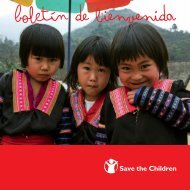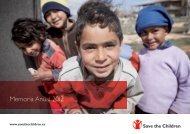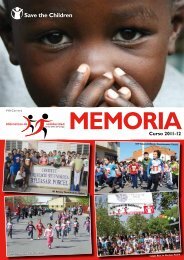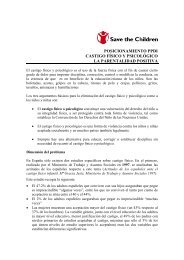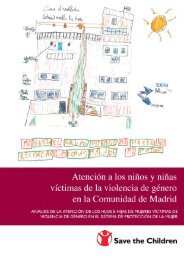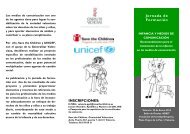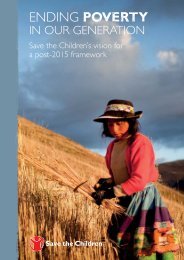Nutrition in the First 1,000 Days - Save the Children
Nutrition in the First 1,000 Days - Save the Children
Nutrition in the First 1,000 Days - Save the Children
Create successful ePaper yourself
Turn your PDF publications into a flip-book with our unique Google optimized e-Paper software.
28 SaviNg liveS aND BUilDiNg a Better FUtUre: loW-coSt SolUtioNS that WorK<br />
national laws that are properly enforced can stop baby food companies from<br />
compet<strong>in</strong>g with breastfeed<strong>in</strong>g. In fact, a recent WHO review of global nutrition<br />
policies found that only a third of <strong>the</strong> 96 countries reported to have enacted<br />
Code legislation also had effective monitor<strong>in</strong>g mechanisms <strong>in</strong> place.85<br />
The Top 4 countries on <strong>the</strong> Scorecard – Malawi, Madagascar, Peru and <strong>the</strong><br />
Solomon Islands – are also regional leaders <strong>in</strong> terms of child survival. Malawi<br />
and Madagascar have made more progress <strong>in</strong> reduc<strong>in</strong>g under-5 mortality than<br />
any o<strong>the</strong>r countries <strong>in</strong> sub-Saharan Africa. Peru has made <strong>the</strong> most progress<br />
of any country <strong>in</strong> Lat<strong>in</strong> America. And Solomon Islands has one of <strong>the</strong> lowest<br />
rates of child mortality <strong>in</strong> <strong>the</strong> East Asia and Pacific region. These countries have<br />
also made improvements <strong>in</strong> early <strong>in</strong>itiation of breastfeed<strong>in</strong>g and o<strong>the</strong>r feed<strong>in</strong>g<br />
practices <strong>in</strong> recent years.<br />
The Bottom 4 countries – Somalia, Côte d’Ivoire, Botswana and Equatorial<br />
Gu<strong>in</strong>ea – have made little to no progress <strong>in</strong> early feed<strong>in</strong>g or <strong>in</strong> sav<strong>in</strong>g children’s<br />
lives. Somalia, <strong>the</strong> lowest-ranked country on <strong>the</strong> Scorecard, has made no progress<br />
s<strong>in</strong>ce 1990 <strong>in</strong> reduc<strong>in</strong>g under-5 mortality, and <strong>in</strong> recent years <strong>the</strong> prevalence of<br />
underweight and stunted children <strong>in</strong> Somalia has risen by at least 10 percentage<br />
po<strong>in</strong>ts.86<br />
Top 4 Countries<br />
Malawi tops <strong>the</strong> Infant and Toddler Feed<strong>in</strong>g Scorecard rank<strong>in</strong>g, demonstrat<strong>in</strong>g<br />
impressive achievements <strong>in</strong> child nutrition. Overall, Malawi is do<strong>in</strong>g a<br />
very good job of feed<strong>in</strong>g young children accord<strong>in</strong>g to recommended standards,<br />
and this is sav<strong>in</strong>g many lives. With<strong>in</strong> an hour after birth, 95 percent of<br />
babies <strong>in</strong> Malawi are put to <strong>the</strong> breast. At 6 months, 71 percent are still be<strong>in</strong>g<br />
exclusively breastfed, and between 6-9 months, 87 percent are breastfed with<br />
complementary foods. At age 2, 77 percent of children are still gett<strong>in</strong>g some of<br />
<strong>the</strong>ir nutrition from breast milk. Malawi has enacted many provisions of <strong>the</strong><br />
International Code of Market<strong>in</strong>g of Breast-milk Substitutes <strong>in</strong>to law and has put<br />
significant energy and resources <strong>in</strong>to improv<strong>in</strong>g health services for its people.<br />
Many improvements can be attributed <strong>in</strong> part to <strong>the</strong> work of 10,<strong>000</strong> health<br />
surveillance assistants who are deployed <strong>in</strong> rural areas. These tra<strong>in</strong>ed, salaried<br />
frontl<strong>in</strong>e workers deliver preventative health care and counsel families about<br />
healthy behaviors such as hygiene, nutrition and breastfeed<strong>in</strong>g (see <strong>the</strong> story of<br />
one health worker on page 35). Malawi is an African success story, hav<strong>in</strong>g reduced<br />
its under-5 mortality rate by 59 percent s<strong>in</strong>ce 1990. It is one of a handful of sub-<br />
Saharan African countries that are on track to achieve MDG 4. While Malawi<br />
is to be applauded for its results <strong>in</strong> promot<strong>in</strong>g breastfeed<strong>in</strong>g and sav<strong>in</strong>g lives,<br />
<strong>the</strong> country still has one of <strong>the</strong> highest percentages of stunted children <strong>in</strong> <strong>the</strong><br />
world (48 percent). This paradox <strong>in</strong>dicates that additional efforts are needed to<br />
ensure children get good nutrition as <strong>the</strong>y are weaned off breast milk.<br />
Madagascar is ano<strong>the</strong>r African success story, on track to achieve MDG 4,<br />
with a 61 percent reduction <strong>in</strong> child mortality s<strong>in</strong>ce 1990. Strong performance<br />
on <strong>in</strong>fant and young child feed<strong>in</strong>g <strong>in</strong>dicators has contributed to Madagascar’s<br />
success <strong>in</strong> sav<strong>in</strong>g hundreds of thousands of lives.87 Madagascar’s M<strong>in</strong>istry of<br />
Health, <strong>in</strong> partnership with <strong>the</strong> AED/L<strong>in</strong>kages Project (funded by USAID),<br />
launched a major effort <strong>in</strong> 1999 to raise public awareness of <strong>the</strong> benefits of<br />
breastfeed<strong>in</strong>g. The campaign used <strong>in</strong>terpersonal communications, community<br />
mobilization events and local mass media to reach 6.3 million people<br />
with positive messages about breastfeed<strong>in</strong>g. S<strong>in</strong>ce <strong>the</strong> launch of <strong>the</strong> project,<br />
exclusive breastfeed<strong>in</strong>g rates have <strong>in</strong>creased from 41 to 51 percent and timely<br />
<strong>in</strong>itiation of breastfeed<strong>in</strong>g with<strong>in</strong> an hour of birth has risen from 34 to 72<br />
percent.88 Madagascar also does well on measures of complementary feed<strong>in</strong>g<br />
(89 percent) and breastfeed<strong>in</strong>g at age 2 (61 percent). Madagascar has enacted<br />
most provisions of <strong>the</strong> breast-milk substitutes Code <strong>in</strong>to law. As <strong>in</strong> Malawi,<br />
Malawi






